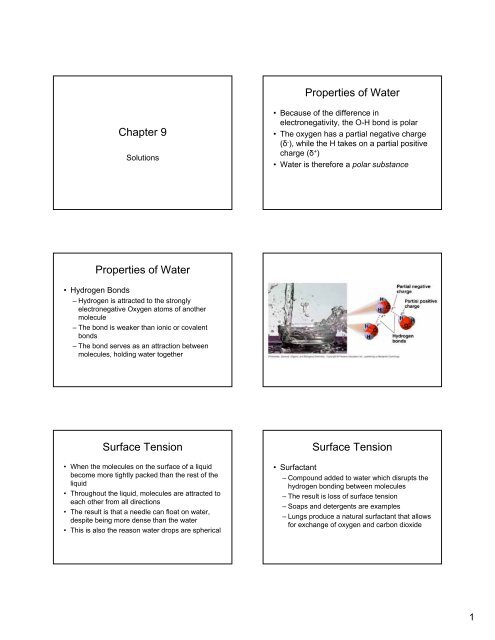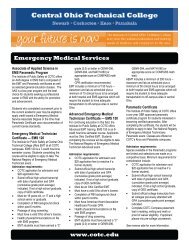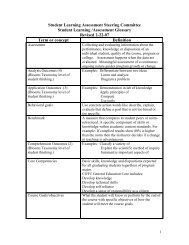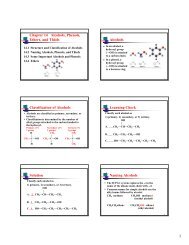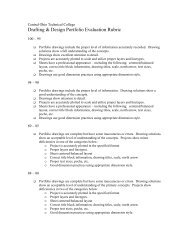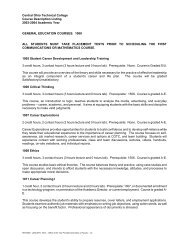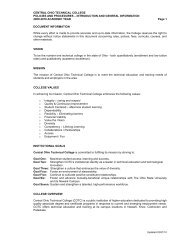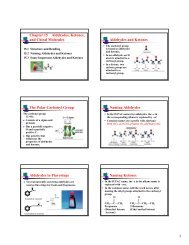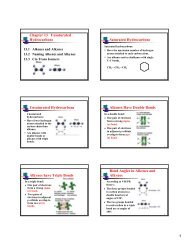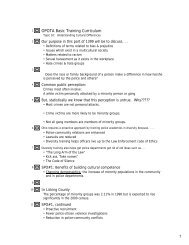Chapter 9 Properties of Water Properties of Water Surface Tension ...
Chapter 9 Properties of Water Properties of Water Surface Tension ...
Chapter 9 Properties of Water Properties of Water Surface Tension ...
You also want an ePaper? Increase the reach of your titles
YUMPU automatically turns print PDFs into web optimized ePapers that Google loves.
<strong>Properties</strong> <strong>of</strong> <strong>Water</strong><strong>Chapter</strong> 9Solutions• Because <strong>of</strong> the difference inelectronegativity, the O-H bond is polar• The oxygen has a partial negative charge(δ - ), while the H takes on a partial positivecharge (δ + )• <strong>Water</strong> is therefore a polar substance<strong>Properties</strong> <strong>of</strong> <strong>Water</strong>• Hydrogen Bonds– Hydrogen is attracted to the stronglyelectronegative Oxygen atoms <strong>of</strong> anothermolecule– The bond is weaker than ionic or covalentbonds– The bond serves as an attraction betweenmolecules, holding water together<strong>Surface</strong> <strong>Tension</strong>• When the molecules on the surface <strong>of</strong> a liquidbecome more tightly packed than the rest <strong>of</strong> theliquid• Throughout the liquid, molecules are attracted toeach other from all directions• The result is that a needle can float on water,despite being more dense than the water• This is also the reason water drops are spherical<strong>Surface</strong> <strong>Tension</strong>• Surfactant– Compound added to water which disrupts thehydrogen bonding between molecules– The result is loss <strong>of</strong> surface tension– Soaps and detergents are examples– Lungs produce a natural surfactant that allowsfor exchange <strong>of</strong> oxygen and carbon dioxide1
Solutions•A solution exists when one substance (thesolute) is uniformly dispersed throughoutanother substance (the solvent)• There is no reaction between the soluteand solvent• As such, they can be mixed in varyingquantitiesSolutions• Solvents and solutes may be solids,liquids, or gases• The solution has the same physical stateas the solvent• Gases easily form solutions because theparticles are moving so fast that there islittle interaction between gases• When solids or liquid form solutions, theremust be an attraction between particles• NaCl will dissolve inwater because the Na +and Cl - are attracted tothe dipoles <strong>of</strong> the watermolecule• Molecules such as I 2 , oils,or greases do notdissolve in water becausethey are nonpolarmolecules• “Like Dissolves Like”Solutions2
Solutions• Dissolving a solute– If we put a salt crystal in a beaker <strong>of</strong> water:– The dipoles <strong>of</strong> the water molecules begin towork upon the molecules <strong>of</strong> NaCl on the outeredges <strong>of</strong> the crystal– It takes the pull <strong>of</strong> many water molecules tobreak the bond between the Na and the Cl– Once broken, there is a constant pull <strong>of</strong> manywater molecules on each <strong>of</strong> the Na and Cl– This is the process <strong>of</strong> hydrationHydrates• Solid ionic compounds where watermolecules are part <strong>of</strong> the crystal structure• The water molecules are called water <strong>of</strong>hydration• With the addition <strong>of</strong> heat, the bonds <strong>of</strong> thewater molecules are broken and the waterevaporates• The result is an anhydrantHydratesCuSO +4 • 5H2O(s)⇔ CuSO4(s)5H2O(g )Electrolytes• Solutions containing ions are conductors <strong>of</strong>electricity• Compounds from which ions come are calledelectrolytes• The degree dissociation <strong>of</strong> compoundsdetermines how strong/weak an electrolyte is– Strong electrolytes (i.e. NaCl) dissociate completely– Weak electrolytes (i.e. HF) do not; usually polarcovalent compounds• Strong ElectrolytesNaClMgCl• Weak ElectrolytesElectrolytesH2O( s)⎯⎯→H2O2( s)⎯⎯→NaIONIZATIONHF ⎯⎯ ⎯⎯ →H+( aq)MgRECOMBINATIONHF ←⎯⎯⎯⎯⎯⎯ H++ Cl2+( aq)+ F+−+ F−( aq)+ Cl−−( aq)Electrolytes• Nonelectrolytes– Polar covalent molecules that do notdissociate in water– Dissolve as whole moleculesC12H22O11( s)H2O⎯⎯→C12H22O11( aq)3
Equivalents• The amount <strong>of</strong> an ion needed to make 1 mole <strong>of</strong>positive or negative charge• For an ion with a charge <strong>of</strong> 2 + , there are 2equivalents for each moleSolubility• Amount <strong>of</strong> a solute that can dissolve in agiven amount <strong>of</strong> solvent at a giventemperature•Factors:– Type <strong>of</strong> solute or solvent– Temperature• Usually expressed grams <strong>of</strong> solute in 100grams <strong>of</strong> solventSolubility• If the solute dissolves easily, the solution is notat maximum capacity and is said to beunsaturated• When the solution contains all the solute it candissolve, it is saturated• Adding more solute to a saturated solution willresult in the solute sitting on the bottom <strong>of</strong> thecontainer• At saturation, an equilibrium exists between thedissolving and crystallizing processes4
Effect <strong>of</strong> Temperature• Solubility <strong>of</strong> solids increases withtemperature• Solubility <strong>of</strong> gases decreases withincreasing temperature– As the temperature increases, the moleculeshave more energy to escapeHenry’s Law• The solubility <strong>of</strong> a gas in a liquid is directlyrelated to the pressure <strong>of</strong> that gas above theliquid• For example, in a pop can, CO 2 is injected intothe space above the liquid, creating a highpressure, and forcing the CO 2 to dissolve• When the can is opened, the pressure drops,and so does the solubility. Gas bubbles escape.Insoluble Salts• Ionic compounds discussed up to nowhave been soluble in water – soluble salts• Ions that do not separate in water arecalled insoluble salts• Soluble salts almost always contain one <strong>of</strong>the following:–Li + , Na + , K + , NH 4+ , NO 3-• The attractive forces within insoluble saltsare too strong to be pulled apart5
Solubility• Formation <strong>of</strong> a solid– Mixing <strong>of</strong> two solutions may result in a solidprecipitate formingPercent ConcentrationConcentration =<strong>of</strong> a solutionamount <strong>of</strong> soluteamount <strong>of</strong> solution• Mass percent– Percent by mass <strong>of</strong> a solute within a solution8.0gKCl + 42.0g H2O= 50g solution– Both solution and solute are measured on abalanceMass % = mass <strong>of</strong> solute (g) × 100%8.0g<strong>of</strong> KClmass <strong>of</strong> solution (g) × 100% = 16%50g<strong>of</strong> solutionPercent Concentration• Volume Percentvolume (mL) solutevolume % =× 100%volume (mL) solution• Mass/Volume Percentmass (g) solutemass/volum e % =× 100%volume (mL) solution6
Molaritymoles <strong>of</strong> soluteMolarity (M) =Liters <strong>of</strong> solutionColloids• Large molecules in homogeneousmixtures that do not separate• Four types <strong>of</strong> colloids– Aerosols: liquid or solid dispersed in a gas– Foams: gas or liquid in solid– Emulsion: liquid in a liquid or solid– Sol: Solid in a liquid or solidSuspensions• Heterogeneous, non-uniform mixtures• Often have VERY large particles• Particles settle when agitation stops• Often include medicines or products whichdictate: Shake well before using7


